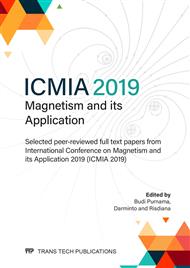[1]
Leslie-Pelecky, D.L., Zhang, X.Q., and Rieke, R.D., Self-Stabilized Magnetic Colloids: Ultrafine Co Particles in Polymers, J. Appl. Phys. 79 (1996) 5312-5314.
DOI: 10.1063/1.361362
Google Scholar
[2]
Dormann J. L., Fiorani D., and Tronc E., Magnetic Relaxation in Fine‐Particle Systems, Advances in Chemical Physics 98 (1997) 283-494.
DOI: 10.1002/9780470141571.ch4
Google Scholar
[3]
R.H. Kodama, Magnetic Nanoparticles, J. Magn. Magn. Mater. 200 (1999), 359-372.
Google Scholar
[4]
Goya G. F., and Morales M. P., Field dependence of blocking temperature in magnetite nanoparticles, Journal of Metastable and Nanocrystalline Materials 20-21 (2004) 673-678.
DOI: 10.4028/www.scientific.net/jmnm.20-21.673
Google Scholar
[5]
Georgia C. Papaefthymiou, Nanoparticle magnetism, Nano Today 4 (2009) 438-447.
Google Scholar
[6]
Balaev D.A., S.V. Semenov, A.A. Dubrovskiy, S.S. Yakushkin, V.L. Kirillov, O.N. Martyanovc, Superparamagnetic blocking of an ensemble of magnetite nanoparticles upon interparticle interactions, J. Magn. Magn. Mater. 440 (2017) 199-202.
DOI: 10.1016/j.jmmm.2016.12.046
Google Scholar
[7]
T. Saragi, N. Syakir, T. H. Nainggolan, C. Alboin and Risdiana, The Effect of Molar Composition of Co2+ to Structure and Magnetic Properties of CoFe2O4 AIP Conf. Proc. 1554 (2013) 123-125.
DOI: 10.1063/1.4820300
Google Scholar
[8]
T. Saragi, L.D. Busrifa, S. Butarbutar, B. Permana, and Risdiana, The Impact of Synthesis Temperature on Magnetite Nanoparticles Size Synthesized by Co-precipitation Method, J. Phys. Conf. Ser. 1013 (2018) 012190-4.
DOI: 10.1088/1742-6596/1013/1/012190
Google Scholar
[9]
T. Saragi, B. Permana, M. Safitri, L.D. Busrifa, S.W. Butarbutar, L. Safriani, I. Rahayu, and Risdiana, The Effect of pH and Sintering Treatment on Magnetic Nanoparticles Ferrite Based Synthesized by Coprecipitation Method, J. Phys. Conf. Ser. 1080 (2018) 012019-23.
DOI: 10.1088/1742-6596/1080/1/012019
Google Scholar
[10]
E.L. Brito, D.N. Gomes, C.C. Plá Cid, J.C.R. de Araújo, F. Bohn, L. Streck, J. L.C. Fonseca, Superparamagnetic magnetite/IPEC particles, Colloids and Surface A 560 (2019) 376-383.
DOI: 10.1016/j.colsurfa.2018.09.067
Google Scholar
[11]
Walton, D., and Williams, Cooling rate of effects in the magnetization of single-domain, J. Geomagn. Geoelectr. 40 (1988) 729-737.
DOI: 10.5636/jgg.40.729
Google Scholar
[12]
Togar Saragi, Bayu Permana, Arnold Therigan, Sahrul Hidayat, Norman Syakir and Risdiana, Physical Properties of Encapsulated Iron Oxide, Material Science Forum 996 (2019) 277-281.
DOI: 10.4028/www.scientific.net/msf.966.277
Google Scholar


